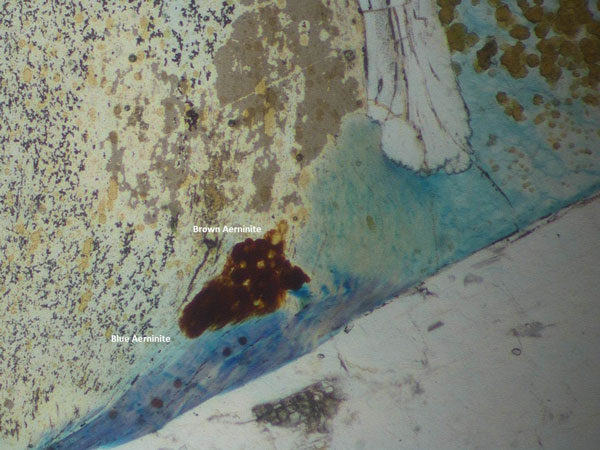

At the left, photomicrograph of a zone of the polished thin section containing, in the middle, brown aerinite and, in the right bottom of the image, pale-blue aerinite. At the right, Romanesque paintings of the apse of Sant Climent, Taüll, where aeriniti was used for covering blue areas.
Cerdanyola del Vallès, 2nd December 2019. Historically, Aerinite is a blue pigment used in many Romanesque paintings of the Pyrenean zone between the XI-XIV centuries. Its characteristic blue color varies from dark to pale-blue. In fact, its name comes from a Greek root "aerinos", meaning "atmosphere" or "sky", since it has been only known as blue. However, it is known that many minerals are present in nature in different colors. With aerinite, one double question still remained open: "Must aerinite always be blue?" and "Is it always blue simply because we can only identify it when it is blue?"
During the inspection of a polished thin section of a specimen coming from Tartareu (Lleida), a small area containing brown submicrometric fibres was detected next to a region containing pale-blue aerinite. A first scanning electron microscopy (SEM-EDX) analysis of this brown region suggested it to be very similar to aerinite, but with a slightly different composition. It had a higher content of iron (Fe), and manganesium (Mn) was partially replacing calcium (Ca).
Synchrotron through-the-substrate microdiffraction
As it was a very small section, and due to the significant compositional difference, reserchers decided to use the synchrotron through-the-substrate microdiffraction (tts-µXRD) technique to collect data and verify that the brown fibres were indeed aerinite. The experiment was carried out at the MSPD beamline of the ALBA Synchrotron.
This technique, developed in close collaboration by researchers of the ICMAB-CSIC and the ALBA Synchrotron, allows the simultaneous visualization of a thin-section of the mineral under polarized light and the measurement of diffraction patterns at the target region previously identified.
The measured tts-µXRD data confirmed that these fibres constitute the first finding of brown aerinite. Compared to the more common blue variety, this new variety has a slightly different unit cell parameter. This information was complemented with the acquisition of accurate electron microprobe (EMP) data of the same zone.
The compositional study of brown aerinite, carried out by Anna Crespí and Jordi Rius of the ICMAB-CSIC in collaboration with Oriol Vallcorba and Igors Šics of ALBA Synchrotron, has been recently published in the European Journal of Mineralogy.




